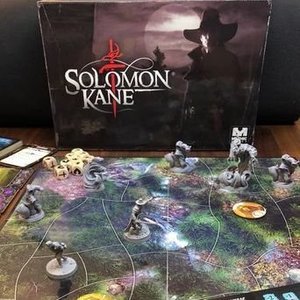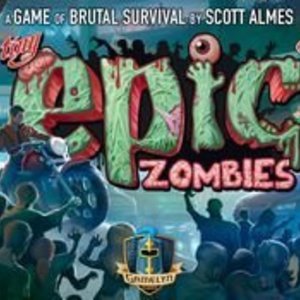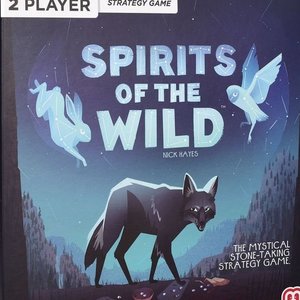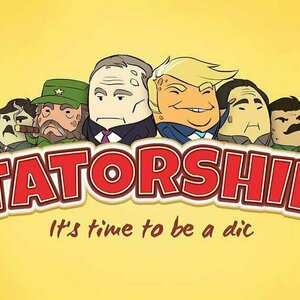
Touch The Video Lite -Fully featured video player
Photo & Video and Utilities
App
Touch The Video Lite is a video player which allows you to easily handle videos with intuitive touch...
Purple Phoenix Games (2266 KP) rated Cosmic Run: Regeneration in Tabletop Games
Jun 12, 2019
Space – the Final Frontier. Well, not anymore. You’re living in the year 2123, and space travel is not a novel idea. In fact, Earth has become uninhabitable, and the human race must find a new planet to call home! You and your team of explorers have taken to the galaxies to find a suitable replacement for the future of mankind. By befriending aliens and outmaneuvering rival explorers, your team will be credited with the discovery of new colonies on these distant planets. It’s a literal Space Race, so kick on that hyper-drive and take to the stars!
Cosmic Run: Regeneration is a competitive or cooperative dice-rolling game in which players are racing to earn the most victory points by being the first to discover new planets. It’s a Yahtzee-style push-your-luck game where you must roll certain sets of identical dice to advance your ships on the individual planet tracks. Dice can also be used to ‘hire’ aliens or find crystals, which can give you special abilities once per game. The planets must be discovered in a timely manner, though, because passing meteors could cause damage to, or even completely destroy, these planets – this is space, after all. Players earn victory points in three ways – by being the first to discover a planet, based on their position on a planet’s track if they are not the first to discover it, or by retiring sets of aliens. The player with the most victory points once all 6 planets are discovered is the winner! When playing solo, the game is played essentially the same way, with some minor differences. If the solo player discovers all 6 planets before any one is destroyed or before the meteor deck runs out, they win! However, if even a single planet is destroyed or they are not all discovered before the meteor deck runs out, the solo player loses.
I enjoy playing Cosmic Run: Regeneration as a solo game because it’s simple, but not easy. You’re just rolling dice, but you need a strategy. Do you try to advance quickly on the easiest tracks, or do you commit dice to more difficult tracks and hope that the dice rolls will be on your side? Be careful – once you commit a die to a certain track, it cannot be moved. I’ve played so many games where I commit dice to Planet 2 (2-of-a-kind) and end up rolling 3 more of the same number that could’ve been used on Planet 5 (5-of-a-kind) if I’d just committed them there in the first place! A lot of the game is dependent on the luck of the roll, but I feel like you still need a solid strategy to be successful. There’s a good balance between the two – I still feel like I’m in control of the game even though I can’t control how the dice will roll.
The one main difference between solo and group play is that the solo player is allowed to spend VPs to create ‘forcefields’ around planets. This is because in group play if a planet is destroyed, players score points for their track progress, and the game continues. For the solo player, however, if a planet is destroyed, the game is over. When playing solo, I can choose to spend either 5 or 10 VPs to create a forcefield around either 1 or all planets to protect them from meteors for one turn. Without this option in solo play, it would be impossible to win. The first 4 cards of the meteor deck are guaranteed to hit 4 different planets, so right off the bat you are starting at kind of a disadvantage. Each planet only takes 3 hits to be destroyed, so depending on how well the meteor deck is shuffled, the game would be over quickly if I weren’t able to create forcefields. It all comes back to strategy – you have to decide when to spend those VPs and what planets need protecting at any given point in the game.
That being said, scoring VPs is not really easy in solo play. To score points for a planet, you have to physically reach the planet surface – and that can take a while depending on how well you are rolling. You can hire/retire aliens for VPs, but alien cards have a die cost, so if you are hiring aliens all the time, those are dice you are not using to advance on planet tracks. And each turn, planets get closer to destruction if you don’t advance on their tracks fast enough. You can earn VPs when you land on a VP token space – you do not pick up the token if you pass it, you must land exactly on it. So all in all, you can’t afford to protect every planet every turn. You have to strategize carefully about how to risk your hard-earned VPs. The most frustrating thing is when I pay VPs to protect a planet that isn’t even the one that gets hit! 5 VPs gone that I usually can’t get back in a single turn. But that’s all part of the push-your-luck isn’t it? There’s no reward without risk, and sometimes it’s better to be safe than sorry. I’m usually not a very risky game player, but in this game I have to be. Playing it safe is not an option when I’m racing against the meteor deck.
Cosmic Run: Regeneration is a game of strategy with some healthy helpings of luck and risk-taking. You need a solid strategy, but one that is flexible enough to adapt to your dice rolls on any given turn. No game is a guaranteed win – if I win it’s usually at the last possible second. This game is easy to play, but not necessarily easy to win and that’s what keeps me coming back to play. Even as a solo game, it’s engaging and I think it’s pretty fun too!
https://purplephoenixgames.wordpress.com/2019/01/25/solo-chronicles-cosmic-run-regeneration/
Purple Phoenix Games (2266 KP) rated Dreams of Tomorrow in Tabletop Games
Sep 17, 2020
Dreams of Tomorrow is game of set collection that utilizes a shifting rondel (I had to look up the definition too) in which players are working to weave a series of dreams into a complete Dream Sequence. Set in the future, players take on the roles of Dream Engineers, who are tasked with creating Dream Sequences to be sent to the past in an effort to save the future. Can you weave the most powerful Dream Sequence to alter the path of your present life, or is the future doomed to fall?
DISCLAIMER: We were provided a copy of this game for the purposes of this review. This is a retail copy of the game, so what you see in these photos is exactly what would be received in your box. I do not intend to cover every single rule included in the rulebook, but will describe the overall game flow and major rule set so that our readers may get a sense of how the game plays. For more in depth rules, you may purchase a copy online or from your FLGS. -L
To setup the game, place the Collective Consciousness (the rondel) in numerical order within reach of all players. Reveal a number of Dream cards from the Dream deck, based on the number of players, and these cards will create the communal Dreamscape. Each player receives a player card, cubes, and meeple in their chosen color, and sets their resources to the starting numbers, as described in the rulebook. All players begin with their meeples in the first space of the rondel, and in clockwise order, will select and pay for a Dream from the Dreamscape to be placed in their Dream Catcher (waiting area). Once all players have selected a Dream, and adjusted their resources accordingly, the game is ready to begin.
Dreams of Tomorrow is played over a series of rounds in which players will take turns performing 2 actions: Move and Take Action. Movement happens sequentially around the rondel, and players may choose how many spaces to move. To move 1-3 spaces is free, but to move more than 3 spaces will cost a number of resources. When a player decides to end their movement, they will then take the action indicated on the space on which they landed. These actions include: Gaining resources, Catching a Dream, Weaving a Dream, or Activating a Dream Ability. Gaining resources is pretty self-explanatory, and there is one neat thing to note: even if it is not your active turn, most of the rondel spaces have a Shared Effect, which grants an off-turn action to all non-active players. Catching a Dream means that you pay the requisite resources and select a Dream from the Dreamscape. Any caught Dreams go into your Dream Catcher until you are able to perform the Weave a Dream action. When you Weave a Dream, you again pay the requisite resources displayed on the Dream card and move the Dream from your Dream Catcher into your Dream Sequence (play area). To Activate a Dream Ability, you select a Dream card in your tableau, and use the ability printed on it. It is important to note that once Dreams are woven into your Dream Sequence, they will overlap each other, and only one Dream Ability will ever be available for use, so create that sequence wisely! Play continues in turns until one player has woven a Dream Sequence of five Dreams total. The round ends once all players have taken the same number of turns, and then final points are counted. The player with the highest score is the winner!
So all-in-all, how is Dreams of Tomorrow as a whole? I actually was very surprised at how much I enjoyed this game. When reading through the rules, it seemed kind of complicated and I was a bit worried before my first play. Once you actually get playing, however, the game is pretty intuitive and simple to play. One thing I particularly enjoyed about this game is its iconography. With only three resources and four actions, there are only seven icons of which to keep track. It keeps the cards from being cluttered with text, and makes the costs/abilities clear to understand. The iconography of the Dream Abilities, however, can be a liiiittle more complicated, but the game does come with Reference Cards which explain what every single icon means!
Another neat thing I enjoyed about this gameplay is the addition of Shared Effects. Even if you are not the active player, you will always gain some resource on everyone else’s turn. That adds an extra element of strategy because you have to amass your own resources for Dreams, but you have to be careful not to be giving your opponents too much extra help for themselves! Probably my favorite part of Dreams of Tomorrow are the actual Dream Abilities themselves. Performing the regular turn actions are pretty straight-forward, but Dream Abilities are more special and allow you to do even more on your turn. For example, some Dream Abilities allow you to change directions, move extra spaces, or even alter the Collective Consciousness, re-arranging the cards in a way to benefit you and hopefully hinder your opponents. The Dream Abilities are literal game-changers, and they really keep all players on their toes.
Talking about components, this game is of a pretty good quality. The cards are nice and sturdy, the player boards are decent, and the meeples and cubes are your standard wooden tokens. I’ve said in reviews before, but I always appreciate when games include Reference Cards for players, and Dreams of Tomorrow certainly delivered on theirs. The cards are clear, concise, and helpful during play. The artwork of this game is very vibrantly colorful and just plain pretty to look at. I found myself getting distracted by admiring the artwork, or catching Dreams based on their artwork, instead of taking their point-values or resources requirements into consideration. Oops. That’s just my bad, but the artwork really helps make the game more immersive.
Overall, I would say that Dreams of Tomorrow is a great little game. Admittedly, the rulebook is kind of daunting and seems a little overly complicated at first, but once you get into an actual game, it flows very quickly and easily. After just one turn, I got exactly what was happening and had no further questions about the gameplay. It really went above and beyond my expectations, and is one that I definitely look forward to bringing out in future game nights. Purple Phoenix Games gives it a dreamy 10 / 12. Check this one out if you haven’t before, it may just be the game of your dreams. (Ha, get it?)

OPlayer - video player, classic media streaming
Entertainment and Music
App
Play all your videos directly without having to convert them! OPlayer supports almost every format...

Osmos for iPad
Games and Entertainment
App
** Apple Design Award winner and iPad Game of the Year! ** Enter the Darwinian world of a galactic...

Solomon Kane
Tabletop Game
Solomon Kane is a dour English Puritan and redresser of wrongs. He roams the world, fighting against...
Boardgames NovelsintoGames 2019Games
Purple Phoenix Games (2266 KP) rated Tiny Epic Zombies in Tabletop Games
Jun 12, 2019
Our next Tiny Epic game review brings us to the world of Zombies! Travis and I kickstarted this game last year, and it’s been a unique addition to the Tiny Epic series. Don’t let the adorable zombies fool you – the game requires a good amount of teamwork and strategy to be successful! And it can be played either cooperatively or competitively – a choice that I have not seen executed in a game before. So read on, fellow gamers, to decide if you have what it takes to survive this zombie infestation alive!
Disclaimer: There are 5 different game modes for Tiny Epic Zombies, but we have only played the completely Cooperative Game vs. an AI Zombie player. Once we have played the other game modes, we will either amend this review or write a new one! – L
Welcome to Tiny Epic Zombies – a cooperative game in which players must successfully complete 3 objectives before they are overrun by zombies. Players take on the role of mall-goers (each with a special ability) who have thus far survived the zombie outbreak. Players will move throughout the mall, battling zombies and picking up supplies, while working towards completing communal objectives. If all 3 objectives are completed, the players win! If the Search Deck runs out, or if the zombies take control of the courtyard and its remaining survivors, the players have lost the game.
For such a ‘tiny’ game, there really is a lot going on. Each player’s turn consists of 3 moves, after each of which the player may A) kill a zombie, B) use room abilities and/or interact with tokens, and C) collect items. It is important to note, players may only perform the B and C actions if there are no zombies remaining in any room of their current store. At the end of their turn, the player will reveal their Search Card (drawn blindly), and will add zombies to the mall accordingly. After zombies are added, the player blindly draws a new Search Card, and play continues. If the Search Deck runs out at any point in the game, players get one final turn to complete their objectives, otherwise they lose!
Simple, right? Not exactly. I know for me, personally, it can be hard to keep track of my turns since each of your 3 moves could potentially allow you to perform 3 additional actions. Turns can get a little muddled with so much to do if you are not paying close attention. After a few plays, it gets easier to remember the turn order, but even then I still keep the rule book on hand to double-check all of my turns.
Ultimately, the thing that can make or break a game is what objectives the players are trying to complete. You shuffle, randomly draw 3 objectives, and go from there. Some objectives are pretty involved and require lots of action to complete, while others are pretty straight-forward and simple. If you draw 3 tough ones (like we did in our first game together), it could be very difficult to succeed. The right combination of objectives can make the game super fun, but unless you hand-pick them for a balanced game, there’s always the chance you’ll get the hardest ones at once. Regarding the objectives though, I do really like that this game can be cooperative – everyone must pitch in to help, and no single player is the ‘hero.’ You have to work closely with the other players to determine the best strategy in order to complete the objectives as quickly as possible. Some objectives can be a challenge for sure, but being able to divvy up certain responsibilities can help make the game feel more manageable.
Overall, I like this game because it’s cute (just look at those little zombies!), cooperative (yay teamwork!), and challenging. There’s kind of a learning curve for turn order, but once you get the hang of it, and collectively figure out the best strategy for objective completion, the game is pretty enjoyable! Purple Phoenix Games gives this installment a bloodied 17 / 24.
https://purplephoenixgames.wordpress.com/2019/01/14/tiny-epic-zombies-reviews/
Purple Phoenix Games (2266 KP) rated Spirits of the Wild in Tabletop Games
Aug 15, 2019
This is a game about resource management, set collection and a hint of take that. The winner of the game is the player who can most efficiently use the stones they choose from the bowl during the game by assigning them to areas on their player mat. Each area scores points differently, and the game ends at the end of the player’s turn once at least five clear stones have left the provided bag. Let me explain.
DISCLAIMER: I do not intend to cover every single rule included in the rule book, but will describe the overall game flow and major rule set so that our readers may get a sense of how the game plays. For more in depth rules, you may purchase a copy from the publisher directly, from Target, or from your FLGS. -T
To setup the game, place all the stones in the bag. Place the bowl in the middle of the players, and set aside the coyote mini. Place the two stacks of Spirit Cards in the middle of the table. Each player receives a play mat and the same set of cards that indicates an action that can be taken on a turn. Draw out four stones from the bag and place them in the bowl. You are ready to begin.
On a player’s turn, they choose a face up card from the collection in front of them which tells them what to do on their turn. Such actions include take a stone, take two stones, or place some stones in the bowl and take one. Once an action card has been chosen and followed, the player flips it over and it cannot be used on the next turn. One card that can be used at any time instructs the player to take a Spirit Card action and refresh their cards by flipping them all face-up. The cards drive the actions to be made throughout the game, but the game really hinges on the stones and the coyote.
When you take actions to choose stones from the bowl you then have to assign those stones to spots on your play mat. These areas score differently and deciding which stones to grab and where to place them can be agonizing, but only because you can see what your opponent is doing and you really need to set yourself up to score points before the game suddenly has to end and you are stuck unfinished and will be unscoring. Unscoring? You’re welcome, Webster’s Dictionary. The coyote, when placed on an opponent’s play mat prevents stones from being added to that area and can really throw an ACME wrench into your plans. So determining when to move the coyote from your mat onto your opponent’s may really be the difference between sweet, tasty victory and bitter, yucky defeat. Again, play continues until the end of the turn when the fifth clear stone leaves the bag. Oh those clear ones? When placed, you can no longer place stones in that area but will also double that area’s score at the end of the game. So there’s quite a bit going on in your head throughout the game. Delicious!
Components. Well, I kinda already professed my love for them in the intro, so I’ll do it again here. They are wonderful components! I want to just be fidgeting with them all the time.
So is this good? Verily!! The constant struggle between deciding your action card based on the stones in the bowl or refreshing your cards or just going for broke and taking a chance on unscoring an area because there are already three clear stones out but you know at any time three more can make an appearance and end the game is just so satisfying. The components are amazing, the game play is fast and furious (not a sponsor), and you just want to play it again right afterward. Those are my favorite kind of games. If this all sounds like your kind of game, definitely check it out. You won’t be disappointed. I believe anyone would like this one. Purple Phoenix Games gives this one an enthusiastic, but temptation-to-eat-the-stones-resisting 10 / 12.
Purple Phoenix Games (2266 KP) rated Tatorship in Tabletop Games
Feb 18, 2020
Disclaimer: We were provided a copy of this game for the purposes of this preview. This is not the finished product, so some of the components may change in the final printing. -L
Tatorship is a card game of hand management and bidding in which players are racing to complete their secret political missions before their opponents. To set up the game, place the 6 Rights in their respective piles in ascending order. Each player randomly selects a Tator, Top Secret Mission, Bottom Secret Mission, and Executive Mission, as well as Action cards and a Bluff card. The Tator is your character, and provides a unique Executive power. The Mission cards (Top, Bottom, and Executive) each refer to specific Rights in the play area. Action cards provide resources necessary for interacting with the Rights, and for use during the Election.
On your turn, you interact with the current Rights on the table. The Rights in play act as the ‘rules’ for the current round. For example, one Right tells you how many Action cards to draw each turn, and another tells you what your hand limit is at the end of your turn. During this phase, you will also have the opportunity to ‘erode’ (remove) Rights from play. To erode a Right, you must pay the resources displayed on the Right card. Each Right has 4 cards, and the bottom-most card must be showing for that Right to be considered to be completely eroded. Your secret Missions require you to erode specific Rights in play, so you must strategize how to use your resources to best benefit your Missions. After all players have taken a turn, the game moves to the Election phase. During the Election, players are casting votes (the # of resources on the Action card is the # of votes it is worth) in an effort to elect a player to be the Executive for the next round. The Executive goes first in the next round, and gets to assign Roles to all players. In order to complete your Executive mission, you must have the Executive card at time of completion. You can vote for an opponent, as well as yourself. Cast a vote with your Bluff card, however, and your votes do not count! Trick your opponents into thinking you’ve voted for them, but reveal the Bluff and get those votes back. Didn’t win the Election? That’s ok! Take a Backstab card as a condolence. Backstab cards can be played at any time and can negatively affect your opponents, or could give you a leg up over opponents. Play continues until one player has completed all 3 of their secret Missions.
If you are confused at all by the rules/gameplay overview above, I have to admit that I am too. The rules provided with this game are extremely vague and confusing to understand. Not even a rulebook, these rules are compiled on 3 separate playing cards. The text is sparse, ambiguous, and contradictory. For example, one card says that each Right is followed once per turn per player, but in any order. But one of the Rights pertains to the Election phase, which I believe only happens once per round? Or does it happen on every single players’ turn since each Right is supposed to be followed by every player on every turn? The ambiguity of the rules bleeds over into other cards as well. Some cards say to ‘discount’ a Right, but nowhere does it say what ‘discount’ means. Do you immediately erode that Right by one? Or do you just pay one fewer resource to erode? There is no clarification anywhere, and that made this game frustrating to play.
Another qualm with this game is that it is supposed to be educational, but I do not think it achieves its goal. I do have to commend the creators for their efforts, but I think they fall flat. Every Action card has small text at the bottom that details the political concept addressed on the card. Here’s the catch – the text is educational, but it is so small that it can be easily ignored. It also has no bearing whatsoever on the gameplay, so I have to admit that I almost never read any of that extra text.
In theory, this game could be fun and educational. In actuality, though, it falls flat. The ambiguity of the rules meant that we played differently nearly every time. We tried interpreting the rules in several ways, but ultimately we just got frustrated by not knowing how everything actually works. With some serious rules work, this game has the potential to be something good. But in its current state, it feels more like a half-baked potato.





